Gear Types, Spur, Helical, Bevel, Rack and Pinion, Worm
Gear Products and Suppliers | Gear Knowledge Menu
Spur Gears: Spur gears are the most common type used. Tooth contact is primarily rolling, with sliding occurring during engagement and disengagement. Some noise is normal, but it may become objectionable at high speeds.
|
 |
Rack and Pinion. Rack and pinion gears are essentially a linear shaped variation of spur gears The spur rack is a portion of a spur gear with an infinite radius.
|
 |
Internal Ring Gear: Internal gear is a cylindrical shaped gear with the meshing teeth inside or outside a circular ring. Often used with a spur gear. Internal ring gears may be used within a planetary gear arrangement.
|
 |
Helical Gear: Helical gear is a cylindrical shaped gear with helicoid teeth. Helical gears operate with less noise and vibration than spur gears. At any time, the load on helical gears is distributed over several teeth, resulting in reduced wear. Due to their angular cut, teeth meshing results in thrust loads along the gear shaft. This action requires thrust bearings to absorb the thrust load and maintain gear alignment. They are widely used in industry. A negative is the axial thrust force the helix form causes.
|
 |
Helical Rack Gear: Helical rack gears are linear shaped and meshes with a rotating helical gear.
|
 |
Double Helical Gear: Double helical gear may have both left-hand and right-hand helical teeth. The double helical form is used to balance the thrust forces and provide additional gear shear area.
|
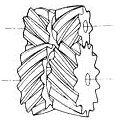 |
Face Gear: Face gears are a circular disc with a ring of teeth cut on one side. The gear teeth are tapered toward the center of the tooth. These gears typically mate with a spur gear.
|
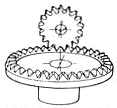 |
Worm Gear: Worm gears teeth resembles ACME screw thread which mates with a helical gear, except that it is made to envelope the worm as seen along the worm's axis. Operation of worm gears is analogous to a screw. The relative motion between these gears is sliding rather than rolling. The uniform distribution of tooth pressures on these gears enables use of metals with inherently low coefficients of friction such as bronze wheel gears with hardened steel worm gears. These gears rely on full fluid film lubrication and require heavy oil compounded to enhance lubricity and film strength to prevent metal contact.
|
 |
Double Enveloping Worm Gear: The double enveloping worm gear has a radial changing pitch diameter. This increases the number and amount of tooth shear area.
|
 |
Hypoid Gear: Hypoid gears are typically found within the differential (rear axle) of automobiles. The gear arrangement allows the translation of torque ninety degrees. Hypoid gears are similar to spiral bevel gears except that the shaft center lines do not intersect. Hypoid gears combine the rolling action and high tooth pressure of spiral bevels with the sliding action of worm gears. This combination and the all-steel construction of the drive and driven gear result in a gear set with special lubrication requirements, including oiliness and anti-weld additives to withstand the high tooth pressures and high rubbing speeds.
|
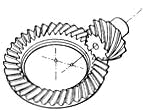 |
Straight Bevel Gear: Straight bevel gears have tapered conical teeth which intersect the same tooth geometry. Bevel gears are used to transmit motion between shafts with intersecting center lines. The intersecting angle is normally 90 deg but may be as high as 180 deg. When the mating gears are equal in size and the shafts are positioned at 90 degrees to each other, they are referred to as miter gears. The teeth of bevel gears can also be cut in a curved manner to produce spiral bevel gears, which produce smoother and quieter operation than straight cut bevels.
|
 |
Spiral Bevel Gear: Spiral bevel gears have a helical angle spiral teeth.
|
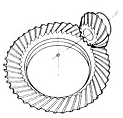 |
Screw Gear (Crossed Helical Gear):
|
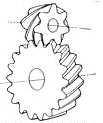 |